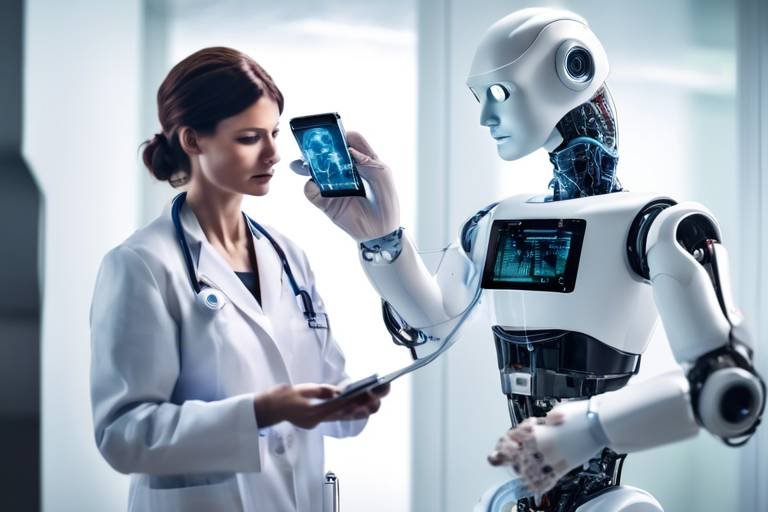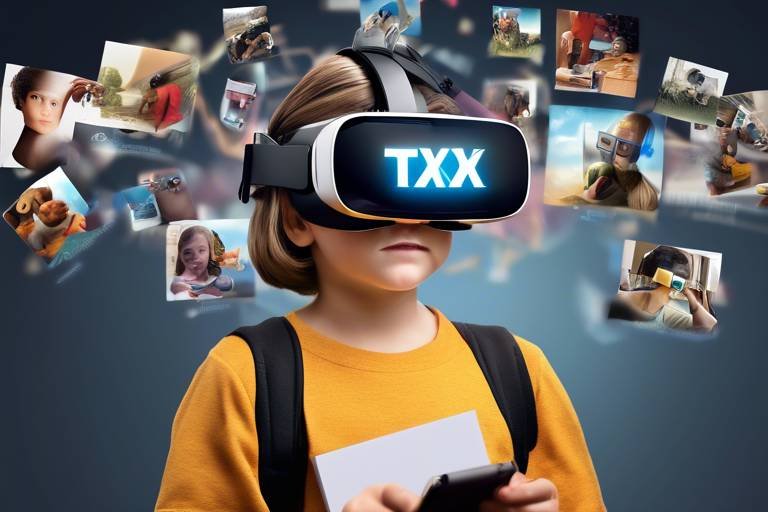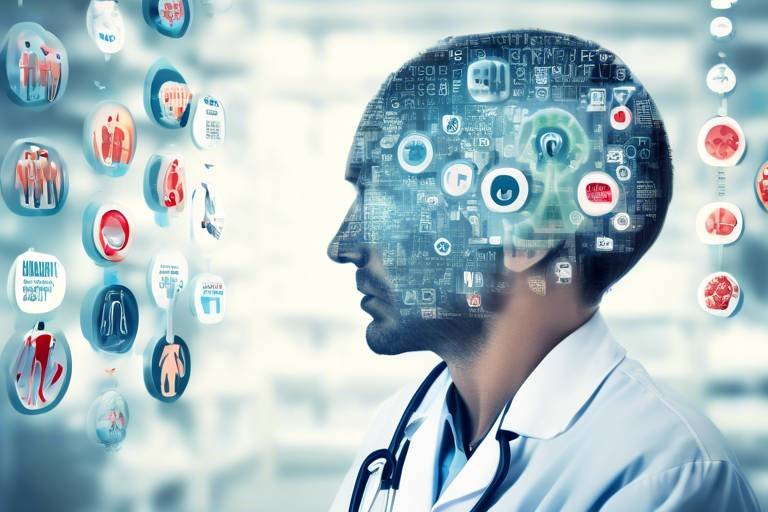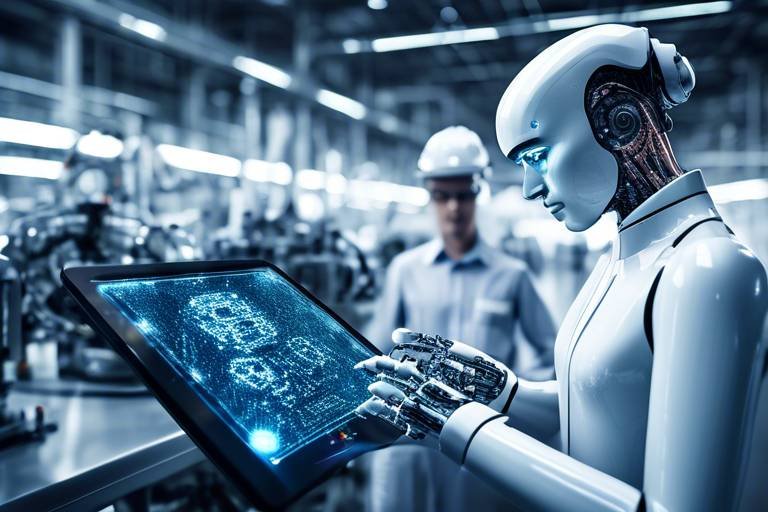The World of Digital Twins: An Emerging Tech Trend
In today’s fast-paced digital landscape, the concept of digital twins has emerged as a game-changer across various sectors. But what exactly are digital twins? Imagine having a virtual mirror that reflects not just the appearance, but the behavior and performance of a physical object or system in real-time. This innovative technology allows organizations to simulate, analyze, and optimize their operations like never before. As we delve deeper into this fascinating world, you'll discover how digital twins are reshaping industries, enhancing decision-making, and paving the way for a smarter future.
At its core, a digital twin is a virtual replica of a physical entity, whether it’s a product, process, or system. This virtual model captures the real-time data and behavior of its physical counterpart, providing invaluable insights into its performance. By utilizing sensors and IoT technology, digital twins can monitor conditions, predict outcomes, and facilitate proactive decision-making. For instance, think of a digital twin like a sophisticated video game character that not only looks like you but also mirrors your every move and decision in the game. This level of simulation opens up a world of possibilities for predictive analytics and operational efficiency.
The applications of digital twins are as diverse as the industries they serve. From manufacturing to healthcare and even urban planning, digital twins are revolutionizing how we approach problem-solving and innovation. By enabling real-time monitoring and optimization of processes, they enhance productivity and service delivery. For example, in manufacturing, companies are using digital twins to streamline production lines, while in healthcare, they are creating personalized treatment plans based on simulated patient outcomes. The versatility of digital twins is truly astounding, making them a cornerstone of modern technological advancement.
In the realm of manufacturing, digital twins have become essential tools for driving efficiency and innovation. They facilitate predictive maintenance, allowing companies to anticipate equipment failures before they occur, thus minimizing downtime. Moreover, digital twins streamline production processes by simulating various scenarios and identifying bottlenecks. This leads to improved quality control, as manufacturers can test different configurations without the need for physical prototypes. The result? A significant boost in operational efficiency and cost savings.
Numerous companies have successfully implemented digital twins to optimize their supply chains and production lines. For instance, a leading automotive manufacturer utilized digital twins to enhance its assembly line operations. By analyzing real-time data, they were able to reduce production time by 30%, showcasing the profound impact of this technology on operational performance. Such case studies highlight the tangible benefits of digital twins, making it clear that they are not just a trend, but a necessity for competitive advantage.
Looking ahead, the integration of artificial intelligence (AI) and Internet of Things (IoT) with digital twins promises to further enhance manufacturing capabilities. As technology continues to evolve, we can expect to see more sophisticated simulations that drive innovation and competitiveness within the industry. This fusion of technologies will not only improve efficiency but also enable manufacturers to respond swiftly to market demands and changes.
In the healthcare sector, digital twins are taking personalized medicine to the next level. By creating virtual models of patients, healthcare providers can simulate treatment outcomes and tailor interventions accordingly. This not only improves patient care but also enhances the design of medical devices, ensuring they meet the specific needs of users. Imagine a doctor being able to run a virtual test on a digital twin of a patient before deciding on a treatment plan—this is the future of healthcare!
Despite their immense potential, digital twins are not without challenges. Organizations face hurdles such as data privacy concerns, integration complexities, and the critical need for skilled personnel to manage these advanced technologies effectively. Addressing these challenges is essential for unlocking the full benefits of digital twins.
Data security is paramount when it comes to digital twins. The sensitive information used in simulations can pose significant risks if not adequately protected. Organizations must implement robust security measures to safeguard against data breaches, ensuring that both organizational and individual privacy is maintained.
Integrating digital twins into existing legacy systems can be a daunting task. It requires careful planning and investment in new technologies to ensure seamless operation and data flow. Organizations must navigate these complexities to fully leverage the advantages that digital twins offer.
- What industries can benefit from digital twins? Digital twins can be applied in various sectors, including manufacturing, healthcare, urban planning, and even agriculture.
- How do digital twins improve decision-making? By providing real-time data and predictive analytics, digital twins enable organizations to make informed decisions quickly and effectively.
- What are the key challenges in implementing digital twins? Major challenges include data security, integration with existing systems, and the need for skilled personnel.

Understanding Digital Twins
Digital twins are not just a buzzword in the tech world; they represent a groundbreaking concept that is revolutionizing how we interact with the physical world. Imagine having a virtual twin of a real-world object, system, or process that mirrors its behavior in real-time. This is precisely what a digital twin does. By leveraging data from sensors and other sources, these virtual replicas provide invaluable insights and predictive analytics that help organizations make informed decisions.
At their core, digital twins combine the physical and digital realms, creating a bridge that allows for enhanced monitoring and optimization. Think of it like having a GPS system for your operations. Just as a GPS helps you navigate through traffic and find the quickest route, digital twins guide businesses in navigating complexities and improving efficiency. They allow for real-time simulations, enabling companies to foresee potential issues before they arise and adapt their strategies accordingly.
The applications of digital twins are vast and varied. They can be utilized in numerous fields, from manufacturing to healthcare, and even urban planning. For instance, in manufacturing, a digital twin of a production line can help identify bottlenecks and inefficiencies, allowing for immediate corrective actions. In healthcare, a digital twin of a patient can be used to simulate different treatment outcomes, leading to more personalized and effective care.
However, understanding digital twins goes beyond just recognizing their functionality. It involves grasping the underlying technologies that make them possible. Key components include:
- Data Collection: Sensors and IoT devices gather real-time data from physical assets.
- Data Analytics: Advanced algorithms analyze this data to create accurate simulations.
- Visualization: User-friendly interfaces display insights and predictions for easy interpretation.
As we delve deeper into the world of digital twins, it's essential to note that they are not a one-size-fits-all solution. The effectiveness of a digital twin is highly dependent on the quality of data and the specific use case. Organizations must invest in the right technologies and strategies to fully harness their potential. The future looks promising, with advancements in artificial intelligence (AI) and machine learning (ML) poised to further enhance the capabilities of digital twins, making them even more integral to modern operations.

Applications Across Industries
Digital twins are not just a buzzword; they are a revolutionary concept that is transforming various industries. Imagine having a virtual counterpart of a physical object or system that can provide you with real-time insights and analytics. This is exactly what digital twins do! By creating a digital replica, businesses can monitor, analyze, and optimize their operations like never before. From manufacturing to healthcare, the impact of digital twins is profound and far-reaching.
In the manufacturing sector, for instance, digital twins allow for the seamless integration of real-time data into production processes. This means that manufacturers can predict equipment failures before they happen, leading to significant cost savings and reduced downtime. Think of it as having a crystal ball that not only shows you the current state of your machinery but also predicts its future performance. As a result, organizations can make informed decisions that enhance productivity and streamline operations.
Meanwhile, in healthcare, digital twins are paving the way for personalized medicine. By simulating individual patient responses to treatments, healthcare providers can devise tailored treatment plans that are more effective. For example, a digital twin of a patient can be used to test how they might respond to a specific medication or procedure, allowing doctors to make better-informed choices. This not only improves patient outcomes but also optimizes resource allocation within healthcare facilities.
Urban planning is yet another area where digital twins are making waves. Cities are becoming increasingly complex, and planners need sophisticated tools to manage urban environments. Digital twins can simulate traffic flows, energy consumption, and even social interactions within a city. This allows city planners to visualize the impact of their decisions before they are implemented, leading to smarter, more sustainable urban development.
Let's take a closer look at some of the key applications of digital twins across various industries:
| Industry | Application | Benefits |
|---|---|---|
| Manufacturing | Predictive Maintenance | Reduced Downtime, Cost Savings |
| Healthcare | Personalized Treatment Plans | Improved Patient Outcomes |
| Urban Planning | Traffic Simulation | Enhanced Urban Development |
| Aerospace | Flight Simulation | Increased Safety, Enhanced Training |
As you can see, the applications of digital twins are vast and varied, impacting numerous sectors in significant ways. The ability to monitor and optimize processes in real-time not only enhances productivity but also fosters innovation. In a world where data is king, leveraging digital twins can provide a competitive edge that is hard to ignore. So, whether you are in manufacturing, healthcare, or urban planning, embracing digital twins could be the key to unlocking new levels of efficiency and effectiveness.

Digital Twins in Manufacturing
In the realm of manufacturing, the advent of digital twins is nothing short of revolutionary. Imagine having a virtual clone of your production line that not only mirrors its physical counterpart but also provides real-time insights into its performance. This concept is transforming how manufacturers operate, enabling them to anticipate issues before they arise and optimize processes like never before. With digital twins, manufacturers can achieve a level of predictive maintenance that was previously unimaginable.
One of the standout benefits of employing digital twins in manufacturing is their ability to facilitate predictive maintenance. Instead of waiting for machinery to fail, companies can monitor the health of their equipment continuously. This proactive approach minimizes downtime and extends the lifespan of machinery, ultimately leading to significant cost savings. For instance, when a digital twin detects an anomaly in a machine's operation, it can alert operators to perform maintenance before a catastrophic failure occurs.
Moreover, digital twins streamline production processes by providing a platform for real-time monitoring. Manufacturers can visualize their entire operation, identifying bottlenecks and inefficiencies in the production line. This level of oversight allows for quick adjustments, ensuring that the production flow remains smooth and uninterrupted. Imagine a factory floor where every machine's performance is tracked in real-time—this is the power of digital twins!
To illustrate the impact of digital twins in manufacturing, consider the following case studies:
| Company | Application | Results |
|---|---|---|
| Siemens | Predictive maintenance for gas turbines | Reduced maintenance costs by 20% |
| General Electric | Real-time monitoring of jet engines | Improved operational efficiency by 15% |
| Boeing | Supply chain optimization | Decreased production time by 30% |
As we look to the future, the integration of artificial intelligence (AI) and the Internet of Things (IoT) with digital twins is set to further enhance manufacturing capabilities. This synergy will not only drive innovation but also foster a new era of competitiveness within the industry. Imagine machines that not only report their status but also learn from past performance to improve future operations. This is the exciting frontier that digital twins are opening up!
In conclusion, digital twins are reshaping the manufacturing landscape, offering unprecedented opportunities for efficiency and productivity. As companies continue to embrace this technology, we can expect to see even more remarkable advancements that will redefine what is possible in manufacturing.
- What is a digital twin? A digital twin is a virtual representation of a physical object or system that simulates its behavior in real-time.
- How do digital twins improve manufacturing? They enable predictive maintenance, streamline processes, and enhance quality control, leading to increased efficiency.
- What industries can benefit from digital twins? While manufacturing is a primary sector, digital twins are also transforming healthcare, urban planning, and more.
- What challenges do digital twins face? Key challenges include data privacy concerns, integration complexities, and the need for skilled personnel.

Case Studies in Manufacturing
The implementation of digital twins in manufacturing has led to remarkable transformations across various companies, showcasing how this innovative technology can drive efficiency and enhance operational performance. For instance, General Electric (GE) has leveraged digital twins to monitor and optimize the performance of its jet engines. By creating virtual models that reflect real-time data from engines in operation, GE can predict maintenance needs, thereby reducing downtime and ensuring that engines operate at peak efficiency. This predictive maintenance approach not only saves costs but also enhances safety and reliability.
Another compelling example is Siemens, which has utilized digital twins in its manufacturing processes to streamline production lines. By simulating the entire production workflow, Siemens can identify bottlenecks and inefficiencies before they become problematic. This proactive approach allows for adjustments in real-time, significantly increasing throughput and reducing waste. In their automotive manufacturing division, the use of digital twins has resulted in a 15% increase in production efficiency, demonstrating the tangible benefits of this technology.
Moreover, BMW has embraced digital twin technology in its vehicle production. The company creates digital twins of its assembly lines, which helps in optimizing the layout and processes. By analyzing the virtual models, BMW can test various scenarios and configurations without interrupting actual production. This method has led to a more agile manufacturing process, allowing BMW to respond quickly to market demands and consumer preferences.
To further illustrate the impact of digital twins in manufacturing, consider the following table that summarizes key case studies:
| Company | Application | Results |
|---|---|---|
| General Electric | Jet Engine Monitoring | Reduced downtime and enhanced safety |
| Siemens | Production Line Optimization | 15% increase in production efficiency |
| BMW | Assembly Line Simulation | More agile manufacturing process |
These case studies not only highlight the versatility of digital twins but also emphasize their potential to revolutionize manufacturing processes. As companies continue to adopt this technology, the results speak for themselves: enhanced productivity, reduced costs, and improved quality control. The trend is clear: digital twins are not just a passing fad; they are a fundamental shift towards smarter manufacturing.
- What is a digital twin? A digital twin is a virtual representation of a physical object or system, used to simulate its behavior and performance in real-time.
- How are digital twins used in manufacturing? Digital twins are used for predictive maintenance, process optimization, and quality control, allowing manufacturers to enhance efficiency and reduce costs.
- What industries benefit from digital twins? Industries such as manufacturing, healthcare, and urban planning are leveraging digital twins for improved decision-making and operational efficiency.
- What challenges do digital twins face? Challenges include data privacy concerns, integration complexities, and the need for skilled personnel to manage these technologies.

Future Trends in Manufacturing
The future of manufacturing is poised for a remarkable transformation, largely driven by the integration of Artificial Intelligence (AI) and the Internet of Things (IoT) with digital twins. As these technologies converge, they will create a more interconnected and intelligent manufacturing ecosystem. Imagine a factory where machines communicate with each other in real-time, predicting failures before they occur and optimizing production processes without human intervention. This scenario is not far-fetched; it’s on the horizon.
One of the most exciting prospects is the use of machine learning algorithms that can analyze vast amounts of data generated by digital twins. These algorithms will enable manufacturers to identify patterns and trends that were previously invisible, leading to smarter decision-making. For instance, a digital twin of a production line could simulate various scenarios, allowing managers to test changes in workflow or machinery without any risk to actual operations. This capability not only enhances operational efficiency but also fosters a culture of innovation.
Moreover, the integration of AI will facilitate predictive analytics on an unprecedented scale. Manufacturers will be able to anticipate maintenance needs and adjust production schedules dynamically based on real-time data. This shift from reactive to proactive management will significantly reduce downtime and operational costs. In fact, studies suggest that companies employing predictive maintenance can reduce maintenance costs by up to 30% to 50% while improving equipment lifespan.
Another key trend is the rise of augmented reality (AR) and virtual reality (VR)
As we look toward the future, sustainability will also play a crucial role in manufacturing trends. Digital twins can help manufacturers analyze their environmental impact, optimize resource usage, and reduce waste. By simulating different production scenarios, companies can find the most sustainable practices that not only benefit the planet but also lower operational costs. For instance, a digital twin could help identify the most efficient energy consumption patterns, leading to reduced carbon footprints and enhanced corporate responsibility.
In conclusion, the future of manufacturing is bright, with digital twins at the forefront of this revolution. As AI, IoT, AR, and sustainability practices continue to evolve, manufacturers who embrace these technologies will not only enhance their operational efficiencies but also position themselves as leaders in a rapidly changing market. The question remains: are you ready to ride the wave of this technological tsunami?
- What are digital twins?
Digital twins are virtual replicas of physical entities that simulate their behavior in real-time, providing insights and predictive analytics for improved decision-making and operational efficiency.
- How are digital twins used in manufacturing?
In manufacturing, digital twins facilitate predictive maintenance, streamline production processes, and improve quality control, leading to reduced downtime and increased efficiency.
- What future trends can we expect in manufacturing?
The integration of AI and IoT with digital twins will enhance predictive analytics, improve operational efficiency, and promote sustainable practices in manufacturing.
- What role does sustainability play in the future of manufacturing?
Sustainability will be a key focus, as digital twins can help manufacturers optimize resource usage and reduce waste, ultimately leading to lower operational costs and a reduced environmental impact.

Digital Twins in Healthcare
In the ever-evolving landscape of healthcare, digital twins are emerging as a groundbreaking tool that is reshaping how we approach patient care and medical innovation. Imagine having a virtual replica of a patient that can simulate their health conditions and predict outcomes based on various treatment options. This is not science fiction; it's the reality of digital twin technology in healthcare.
Digital twins in healthcare are utilized to create personalized treatment plans tailored to individual patients. By analyzing real-time data from wearable devices and electronic health records, healthcare providers can gain insights into a patient's unique health profile. This enables them to simulate different treatment scenarios, allowing for more informed decision-making. For instance, a digital twin of a patient with chronic illness can help doctors understand how specific medications might affect their condition, leading to more effective and targeted therapies.
Moreover, digital twins are revolutionizing the design and testing of medical devices. By creating virtual models of these devices, engineers can simulate their performance under various conditions before they are manufactured. This not only accelerates the development process but also significantly reduces the risk of errors. Imagine being able to test a new heart valve in a virtual environment, tweaking its design based on simulated outcomes, before it ever reaches a patient. This capability enhances innovation and ensures that medical devices are both safe and effective.
Another fascinating application of digital twins in healthcare is in the realm of public health. By creating digital twins of entire populations, health officials can analyze the spread of diseases, evaluate the impact of health interventions, and predict future outbreaks. This proactive approach allows for better resource allocation and more effective public health strategies. For example, during a pandemic, digital twins can help model the effects of different containment strategies, guiding policymakers in making data-driven decisions.
However, the integration of digital twins into healthcare is not without its challenges. Ensuring the security of sensitive patient data is paramount. Healthcare organizations must navigate the complexities of data privacy regulations while harnessing the power of digital twins. Additionally, the need for skilled personnel who can manage and interpret the data generated by these advanced technologies is critical. The healthcare industry must invest in training and development to ensure that professionals are equipped to leverage digital twins effectively.
In conclusion, the potential of digital twins in healthcare is vast and transformative. As technology continues to advance, we can expect to see even more innovative applications that will enhance patient care and operational efficiency. The future of healthcare is not just about treating illness but about understanding it at a fundamental level, and digital twins are leading the charge in this exciting new frontier.
- What is a digital twin in healthcare?
A digital twin in healthcare is a virtual representation of a patient or medical device that simulates behavior and outcomes in real-time, allowing for personalized treatment and improved medical device design.
- How do digital twins improve patient care?
By analyzing real-time data, digital twins enable healthcare providers to create tailored treatment plans, predict patient outcomes, and enhance the safety and effectiveness of medical devices.
- What are the challenges of implementing digital twins in healthcare?
Challenges include data privacy concerns, the complexity of integrating with existing systems, and the need for skilled professionals to manage and interpret the data.

Challenges and Limitations
While the potential of digital twins is undeniably exciting, there are several challenges and limitations that organizations must navigate to fully realize their benefits. One of the most pressing issues is data privacy. As digital twins rely heavily on real-time data from their physical counterparts, the sensitivity of this information can pose significant risks. A breach in data security could lead to not only financial losses but also damage to an organization's reputation. This concern is particularly acute in industries like healthcare, where patient data is involved. Ensuring that robust security measures are in place is crucial for building trust and safeguarding sensitive information.
Another challenge lies in the integration of digital twins with existing systems. Many organizations operate using legacy systems that were not designed with the capabilities of digital twins in mind. This can lead to complex integration issues that require careful planning and substantial investment in new technologies. The transition to a digital twin framework is not just about adopting new software; it's about ensuring that all systems can communicate effectively and that data flows seamlessly across platforms. Without this integration, organizations risk creating silos of information that hinder decision-making and operational efficiency.
Moreover, there is a significant skills gap in the workforce when it comes to managing and utilizing digital twins effectively. The technology is still relatively new, and many professionals lack the necessary training and expertise. Organizations may find it challenging to recruit or train personnel who are proficient in both the technical and analytical aspects of digital twins. This gap can slow down the implementation process and limit the potential benefits that could be gained from this technology.
In summary, while digital twins offer remarkable opportunities for innovation and efficiency, organizations must tackle these challenges head-on. Addressing data security concerns, ensuring smooth integration with existing systems, and investing in workforce training are all critical steps in leveraging the full potential of digital twins. As the technology continues to evolve, overcoming these hurdles will be essential for businesses aiming to stay competitive in an increasingly digital landscape.
- What is a digital twin?
A digital twin is a virtual representation of a physical object or system that simulates its behavior in real-time, allowing for predictive analytics and improved decision-making.
- How are digital twins used in manufacturing?
In manufacturing, digital twins facilitate predictive maintenance, streamline production processes, and enhance quality control, leading to increased efficiency and reduced downtime.
- What are the main challenges of implementing digital twins?
The main challenges include data privacy concerns, integration with existing systems, and the need for skilled personnel to manage the technology effectively.
- Can digital twins be applied in healthcare?
Yes, digital twins can create personalized treatment plans, simulate patient outcomes, and enhance the design of medical devices, ultimately improving patient care.

Data Security Concerns
As we dive deeper into the world of digital twins, one of the most pressing issues that arises is data security. With the increasing reliance on digital twins to simulate real-world entities, the amount of sensitive data being processed is staggering. Imagine a virtual model of a hospital where patient data is constantly updated in real-time; a breach in this system could have dire consequences, not just for the institution, but for the individuals whose information is compromised. This is why ensuring the security of sensitive data used in digital twin simulations is not just a technical requirement, but a moral imperative.
Organizations must recognize that the stakes are high. A security breach can lead to significant risks, including financial loss, reputational damage, and legal repercussions. To illustrate this, consider the following potential impacts of data breaches in digital twin systems:
| Impact | Description |
|---|---|
| Financial Loss | Costs associated with breach remediation, legal fees, and potential fines. |
| Reputational Damage | Loss of customer trust and loyalty, which can take years to rebuild. |
| Legal Repercussions | Potential lawsuits from affected individuals or regulatory bodies. |
To mitigate these risks, organizations must adopt a multi-faceted approach to data security. This includes implementing robust encryption methods, conducting regular security audits, and training personnel on best practices for data handling. Moreover, organizations should consider the following strategies:
- Access Control: Ensure that only authorized personnel have access to sensitive data.
- Regular Updates: Keep software and systems updated to protect against vulnerabilities.
- Incident Response Plans: Develop a clear plan for responding to data breaches, including communication strategies.
In conclusion, while digital twins offer an exciting glimpse into the future of technology and operational efficiency, the concerns surrounding data security cannot be overlooked. Organizations must prioritize the protection of sensitive information to fully leverage the benefits of this innovative technology.
- What is a digital twin? A digital twin is a virtual replica of a physical entity that simulates its behavior in real-time.
- How do digital twins enhance data security? By implementing advanced security measures, organizations can protect sensitive data used in digital twin simulations.
- What industries benefit from digital twins? Industries such as manufacturing, healthcare, and urban planning are leveraging digital twins for improved efficiency and decision-making.

Integration with Existing Systems
Integrating digital twins into existing systems is a challenge that many organizations face. As businesses strive to stay competitive in this rapidly evolving digital landscape, they often find themselves wrestling with legacy systems that were not designed to accommodate such advanced technologies. Imagine trying to fit a modern sports car into a garage built for an old sedan; it’s not just about space, but also about functionality and compatibility. This analogy aptly describes the hurdles that come with integrating digital twins into traditional infrastructures.
One major hurdle is the data silos that exist within many organizations. These silos can prevent seamless data flow, which is crucial for digital twins to function effectively. For instance, if a manufacturing plant has separate systems for inventory management, production scheduling, and quality control, the lack of integration between these systems can lead to inefficiencies and missed opportunities. When a digital twin is deployed, it needs real-time data from all these sources to provide accurate insights and predictive analytics. Without this, the digital twin is like a ship without a compass, unable to navigate through the complexities of operational data.
Moreover, the integration process often requires significant investment in new technologies and training. Organizations may need to upgrade their hardware, implement new software solutions, and invest in the necessary infrastructure to support digital twins. This can be a daunting task, especially for smaller businesses with limited budgets. It's essential to approach integration with a well-thought-out strategy that considers both short-term costs and long-term benefits. A successful integration plan typically includes:
- Assessment of Current Systems: Identify existing systems and their capabilities.
- Data Mapping: Understand how data flows between systems and where bottlenecks occur.
- Technology Upgrades: Invest in new technologies that can support digital twin functionality.
- Training and Development: Ensure staff are trained to use and manage the new systems effectively.
Additionally, organizations must consider the cultural shift that comes with adopting digital twins. Employees may be resistant to change, especially if they are accustomed to traditional ways of working. To overcome this, leaders should foster a culture of innovation and encourage collaboration across departments. By involving employees in the integration process and demonstrating the benefits of digital twins, organizations can create a more receptive environment for change.
In conclusion, while integrating digital twins into existing systems poses challenges, it is not insurmountable. With careful planning, investment in technology, and a commitment to fostering a culture of innovation, organizations can successfully navigate this complex landscape. The reward? Enhanced operational efficiency, improved decision-making, and a significant competitive edge in the market.
1. What are digital twins?
Digital twins are virtual replicas of physical entities that simulate their behavior in real-time, providing insights and predictive analytics for improved decision-making and operational efficiency.
2. How do digital twins integrate with existing systems?
Integration involves assessing current systems, mapping data flows, upgrading technologies, and training staff to ensure a seamless transition and effective use of digital twins.
3. What industries benefit the most from digital twins?
Industries such as manufacturing, healthcare, and urban planning are leading the way in leveraging digital twins for enhanced productivity and service delivery.
4. What challenges do organizations face when implementing digital twins?
Challenges include data privacy concerns, integration complexities, and the need for skilled personnel to manage these advanced technologies effectively.
Frequently Asked Questions
- What exactly is a digital twin?
A digital twin is a virtual representation of a physical object or system. It mirrors the real-world counterpart in real-time, allowing for simulations and predictive analytics that help improve decision-making and operational efficiency.
- How are digital twins used in manufacturing?
In manufacturing, digital twins are employed to facilitate predictive maintenance, streamline production processes, and enhance quality control. This results in reduced downtime and increased overall efficiency, making operations smoother and more cost-effective.
- Can digital twins improve healthcare outcomes?
Absolutely! Digital twins in healthcare allow for the creation of personalized treatment plans and the simulation of patient outcomes. This technology helps in designing better medical devices and ultimately leads to enhanced patient care and operational efficiency.
- What challenges do organizations face when implementing digital twins?
Organizations encounter several challenges, including data privacy concerns, complexities in integrating digital twins with existing systems, and the necessity for skilled personnel to manage these advanced technologies effectively.
- How can data security be ensured in digital twin applications?
To ensure data security, organizations must implement robust security measures such as encryption, access controls, and regular audits. Protecting sensitive data used in simulations is crucial, as breaches can pose significant risks.
- What industries are benefiting the most from digital twins?
Industries like manufacturing, healthcare, urban planning, and even smart cities are reaping the benefits of digital twins. These sectors utilize the technology to optimize processes, enhance service delivery, and improve overall productivity.
- What is the future of digital twins?
The future of digital twins looks promising as advancements in AI and IoT continue to integrate with this technology. This integration will further enhance capabilities, driving innovation and competitiveness across various industries.



















